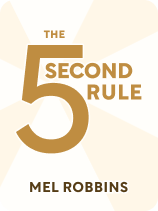

This article is an excerpt from the Shortform book guide to "The 5 Second Rule" by Mel Robbins. Shortform has the world's best summaries and analyses of books you should be reading.
Like this article? Sign up for a free trial here.
What is Mel Robbins’s 5 Second Rule? How can you use the Rule to take control of your life?
In The 5 Second Rule, Mel Robbins explains how you can assert agency over your life by just counting down from five to one over the course of five seconds and acting when you reach one. This method is helpful for those who overthink and hesitate on tasks.
Keep reading to learn more about Mel Robbins’s 5 Second Rule and how it can help you.
The Rule’s Main Uses
What is Mel Robbins’s 5 Second Rule? According to Robbins, you can use the 5-Second Rule to:
- Jump into action
- Be bold and follow your gut
- Control impulsiveness
Let’s explore each use in detail.
1) Using the Rule to Jump Into Action
Robbins notes that the 5 Second Rule gives you a tool to overcome resistance and complete tasks—especially non-habitual tasks—that previously felt impossible due to anxiety, depression, or lack of motivation.
Mental health struggles and lack of motivation often result in us overthinking our actions. According to Robbins, it takes just five seconds for the brain to convince us not to do something if it isn’t already part of our routine. The brain triggers this overthinking to protect us from possible unknown negative consequences of non-habitual action: When we have the impulse to do something that isn’t part of our routine, the brain generates reasons why that new action may lead to negative outcomes.
For example, let’s say you usually stay home and watch Netflix on your days off work. However, you’ve been feeling stressed lately and know you’d benefit from being active—say, by playing tennis with your friends. You have a gut feeling telling you to change your routine and exercise, but you stop to think about it for just a few seconds and your brain starts overthinking: “What if I can’t play as well as I used to and I feel embarrassed? What if I look silly in my workout clothes?” Because you don’t normally exercise and your brain fears that doing so might have negative consequences, you think of all the reasons you shouldn’t exercise despite knowing you should. The thoughts ultimately prevent you from playing tennis with your friends.
However, if you use Robbins’s 5 Second Rule, you count down from five to one when you first notice yourself overthinking. You can then quickly act on your gut feeling before overthinking overwhelms and stops you. For example, when you use the Rule and reach one, you can interrupt your overthinking and send your friends a text message inviting them to play tennis with you later that day. This confirms your plans and makes it more difficult for your brain to talk you out of following through.
2) Using the Rule to Be Bold and Follow Your Gut
Robbins also argues that the 5 Second Rule can help you be bold enough to act on your gut feelings. (Robbins refers to this boldness as everyday courage.) She sees boldness as listening to your values and instincts while working through your fears: for example, signing up for an art class because you want to nurture your creative side even though you’re afraid you might not be any good at it. In this context, the Rule helps you to be bold by jolting you out of a fear-based rut and pushing you to act despite your anxieties.
To Robbins, boldness is essential to taking back control of your life. Acting boldly helps you find fulfillment as you accomplish more than you ever thought possible and realize how much agency you have.
3) Using the Rule to Control Impulsiveness
While the Rule’s main purpose is to encourage action, Robbins argues that it can also help you to control harmful impulses (for example, impulsively saying something hurtful out of anger). She recommends giving yourself five seconds to calm down before you act. Spending a few seconds focusing only on counting backward—and not on your impulse to act harmfully—gives your brain time to dismiss the impulse, thus preventing you from enacting it.
The First Test of the Rule: Getting Out of Bed
Now that we’ve addressed the broad uses of the Rule, let’s explore how Robbins specifically argues you should first use it: to make yourself get out of bed 30 minutes earlier than you normally would.
Robbins explains that there are multiple benefits to making this your first test of the Rule. First, she points out that there are few factors affecting the test, which means there’s no room for excuses if you fail. Success depends only on your alarm clock sounding and you implementing the Rule: Therefore, if you don’t get out of bed, it’s because you didn’t act when you reached one, and not because something else got in the way.
Second, Robbins sees getting out of bed early as a preview of how it feels to apply the Rule. Using the Rule and compelling yourself to act is difficult at first but becomes easier over time. By using the Rule to get out of bed early, you can feel what it’s like to push through this period of struggle (getting out of bed) and reach the point where it’s easy to continue (when you’re up and moving).
The Science Behind the Rule
We’ve explored the main uses of the Rule and Robbins’s suggestion for first implementing it. Now, we’ll discuss the science behind the Rule. Why does it have such a powerful effect on the brain and help us to fight procrastination, hesitation, and harmful impulses? In other words: Why does it work?
Using the Prefrontal Cortex to Challenge Patterns
Robbins argues that counting backward helps us to take control and live more intentionally by shifting the brain away from our habitual thinking patterns. She claims that counting backward activates the prefrontal cortex: the part of the brain that deals with purposeful action, focus, and instigating change. Once that part of the brain is activated, it’s easier for us to focus on challenging our normal patterns.
Robbins argues that challenging our patterns is necessary because most of us are habitually hesitant to act. Hesitating is problematic because it gives us time to consider how we feel about the choices we might make and actions we might take. Then, we let these feelings control our decisions. Robbins claims that even if we logically know that completing a task would benefit us in the long run, when we have time to consider how we feel about that task, we end up abandoning it if it doesn’t feel easy, pleasurable, or comfortable.
For example, if you tend to procrastinate doing your laundry, you likely know that you’ll feel better once it’s complete and you have all of your clean clothes to wear. But, if you stop to think about how you feel about doing your laundry (it’s boring, carrying the heavy hamper is a struggle, and hanging the washing out to dry is a hassle), you’re likely to avoid it.
Creating New Patterns
The Rule not only primes your brain to change your hesitation habit but also allows you to make quick action your new habit, replacing hesitation and doubt. Robbins argues that if you want to break a bad habit, then you have to replace it with something—and acting on the Rule serves as that new, positive habit.

———End of Preview———
Like what you just read? Read the rest of the world's best book summary and analysis of Mel Robbins's "The 5 Second Rule" at Shortform.
Here's what you'll find in our full The 5 Second Rule summary:
- Why counting down from five to one will help you assert agency over your life
- The different ways you can use the 5-Second Rule
- How to figure out what your passions are and work toward them







I love your book